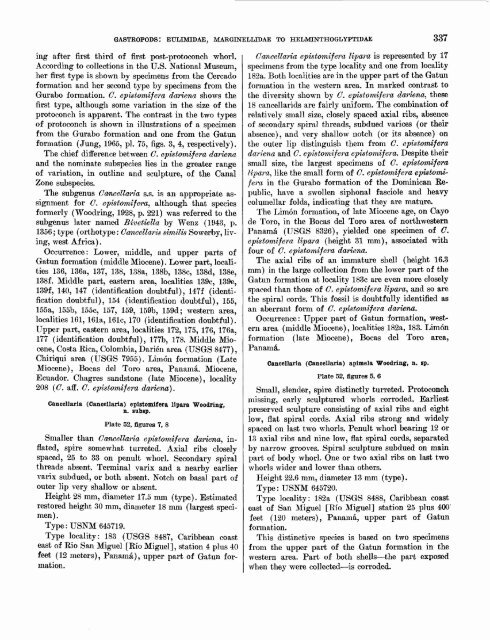Geology and Paleontology of Canal Zone and Adjoining ... - USGS
Geology and Paleontology of Canal Zone and Adjoining ... - USGS
Geology and Paleontology of Canal Zone and Adjoining ... - USGS
You also want an ePaper? Increase the reach of your titles
YUMPU automatically turns print PDFs into web optimized ePapers that Google loves.
GASTROPODS: EULIMIDAE, MARGINELLIDAE TO HELMINTHOGLYPTIDAE 337<br />
ing after first third <strong>of</strong> first post-protoconch whorl.<br />
According to collections in the U.S. National Museum,<br />
her first type is shown by specimens from the Cercado<br />
formation <strong>and</strong> her second type by specimens from the<br />
Gurabo formation. 0. epistomifera dariena shows the<br />
first type, although some variation in the size <strong>of</strong> the<br />
protoconch is apparent. The contrast in the two types<br />
<strong>of</strong> protoconch is shown in illustrations <strong>of</strong> a specimen<br />
from the Gurabo formation <strong>and</strong> one from the Gatun<br />
formation (Jung, 1965, pi. 75, figs. 3, 4, respectively).<br />
The chief difference between C. epistomifera dariena<br />
<strong>and</strong> the nominate subspecies lies in the greater range<br />
<strong>of</strong> variation, in outline <strong>and</strong> sculpture, <strong>of</strong> the <strong>Canal</strong><br />
<strong>Zone</strong> subspecies.<br />
The subgenus Cancellaria s.s. is an appropriate as<br />
signment for C. epistomifera, although that species<br />
formerly (Woodring, 1928, p. 221) was referred to the<br />
subgenus later named SivetieUa by Wenz (1943, p.<br />
1356; type (orthotype: Cancellaris similis Sowerby, liv<br />
ing, west Africa).<br />
Occurrence: Lower, middle, <strong>and</strong> upper parts <strong>of</strong><br />
Gatun formation (middle Miocene). Lower part, locali<br />
ties 136, 136a, 137, 138, 138a, 138b, 138c, 138d, 138e,<br />
138f. Middle part, eastern area, localities 139c, 139e,<br />
139f, 140, 147 (identification doubtful), 147f (identi<br />
fication doubtful), 154 (identification doubtful), 155,<br />
155a, 155b, 155c, 157, 159, 159b, 159d; western area,<br />
localities 161, 161a, 161c, 170 (identification doubtful).<br />
Upper part, eastern area, localities 172, 175, 176, 176a,<br />
177 (identification doubtful), 177b, 178. Middle Mio<br />
cene, Costa Rica, Colombia, Darien area (<strong>USGS</strong> 8477),<br />
Chiriqui area (<strong>USGS</strong> 7955). Limon formation (Late<br />
Miocene), Bocas del Toro area, Panama. Miocene,<br />
Ecuador. Chagres s<strong>and</strong>stone (late Miocene), locality<br />
208 (C. aff. C. epistomifera dariena).<br />
Cancellaria (Cancellaria) epistomifera lipara Woodring,<br />
n. subsp.<br />
Plate 52, figures 7, 8<br />
Smaller than Cancellaria epistomifera dariena, in<br />
flated, spire somewhat turreted. Axial ribs closely<br />
spaced, 25 to 33 on penult whorl. Secondary spiral<br />
threads absent. Terminal varix <strong>and</strong> a nearby earlier<br />
varix subdued, or both absent. Notch on basal part <strong>of</strong><br />
outer lip very shallow or absent.<br />
Height 28 mm, diameter 17.5 mm (type). Estimated<br />
restored height 30 mm, diameter 18 mm (largest speci<br />
men).<br />
Type :USNM 645719.<br />
Type locality: 183 (<strong>USGS</strong> 8487, Caribbean coast<br />
east <strong>of</strong> Eio San Miguel [Eio Miguel], station 4 plus 40<br />
feet (12 meters), Panama), upper part <strong>of</strong> Gatun for<br />
mation.<br />
Cancellaria epistomifera lipara is represented by 17<br />
specimens from the type locality <strong>and</strong> one from locality<br />
182a. Both localities are in the upper part <strong>of</strong> the Gatun<br />
formation in the western area. In marked contrast to<br />
the diversity shown by C. epistomifera dariena, these<br />
18 cancellarids are fairly uniform. The combination <strong>of</strong><br />
relatively small size, closely spaced axial ribs, absence<br />
<strong>of</strong> secondary spiral threads, subdued varices (or their<br />
absence), <strong>and</strong> very shallow notch (or its absence) on<br />
the outer lip distinguish them from G. epistomifera<br />
dariena <strong>and</strong> C. epistomifera epistoinifera. Despite their<br />
small size, the largest specimens <strong>of</strong> C. epistomifera<br />
lipara, like the small form <strong>of</strong> 0. epistomifera epistomi<br />
fera in the Gurabo formation <strong>of</strong> the Dominican Re<br />
public, have a swollen siphonal fasciole <strong>and</strong> heavy<br />
columellar folds, indicating that they are mature.<br />
The Limon formation, <strong>of</strong> late Miocene age, on Cayo<br />
de Toro, in the Bocas del Toro area <strong>of</strong> northwestern<br />
Panama (<strong>USGS</strong> 8326), yielded one specimen <strong>of</strong> C.<br />
epistomifera lipara (height 31 mm), associated with<br />
four <strong>of</strong> C. epistomifera dariena.<br />
The axial ribs <strong>of</strong> an immature shell (height 16.3<br />
mm) in the large collection from the lower part <strong>of</strong> the<br />
Gatun formation at locality 183c are even more closely<br />
spaced than those <strong>of</strong> C. epistomifera lipara, <strong>and</strong> so are<br />
the spiral cords. This fossil is doubtfully identified as<br />
an aberrant form <strong>of</strong> C. epistomifera dariena.<br />
Occurrence: Upper part <strong>of</strong> Gatun formation, west<br />
ern area (middle Miocene), localities 182a, 183. Limon<br />
formation (late Miocene), Bocas del Toro area,<br />
Panama.<br />
Cancellaria (Cancellaria) apimela Woodring, n. sp.<br />
Plate 52, figures 5, 6<br />
Small, slender, spire distinctly turreted. Protoconch<br />
missing, early sculptured whorls corroded. Earliest<br />
preserved sculpture consisting <strong>of</strong> axial ribs <strong>and</strong> eight<br />
low, flat spiral cords. Axial ribs strong <strong>and</strong> widely<br />
spaced on last two whorls. Penult whorl bearing 12 or<br />
13 axial ribs <strong>and</strong> nine low, flat spiral cords, separated<br />
by narrow grooves. Spiral sculpture subdued on main<br />
part <strong>of</strong> body whorl. One or two axial ribs on last two<br />
whorls wider <strong>and</strong> lower than others.<br />
Height 22.6 mm, diameter 13 mm (type).<br />
Type:USNM 645720.<br />
Type locality: 182a (<strong>USGS</strong> 8488, Caribbean coast<br />
east <strong>of</strong> San Miguel [Rio Miguel] station 25 plus 400'<br />
feet (120 meters), Panama, upper part <strong>of</strong> Gatun<br />
formation.<br />
This distinctive species is based on two specimens<br />
from the upper part <strong>of</strong> the Gatun formation in the<br />
western area. Part <strong>of</strong> both shells the part exposed<br />
when they were collected is corroded.

















